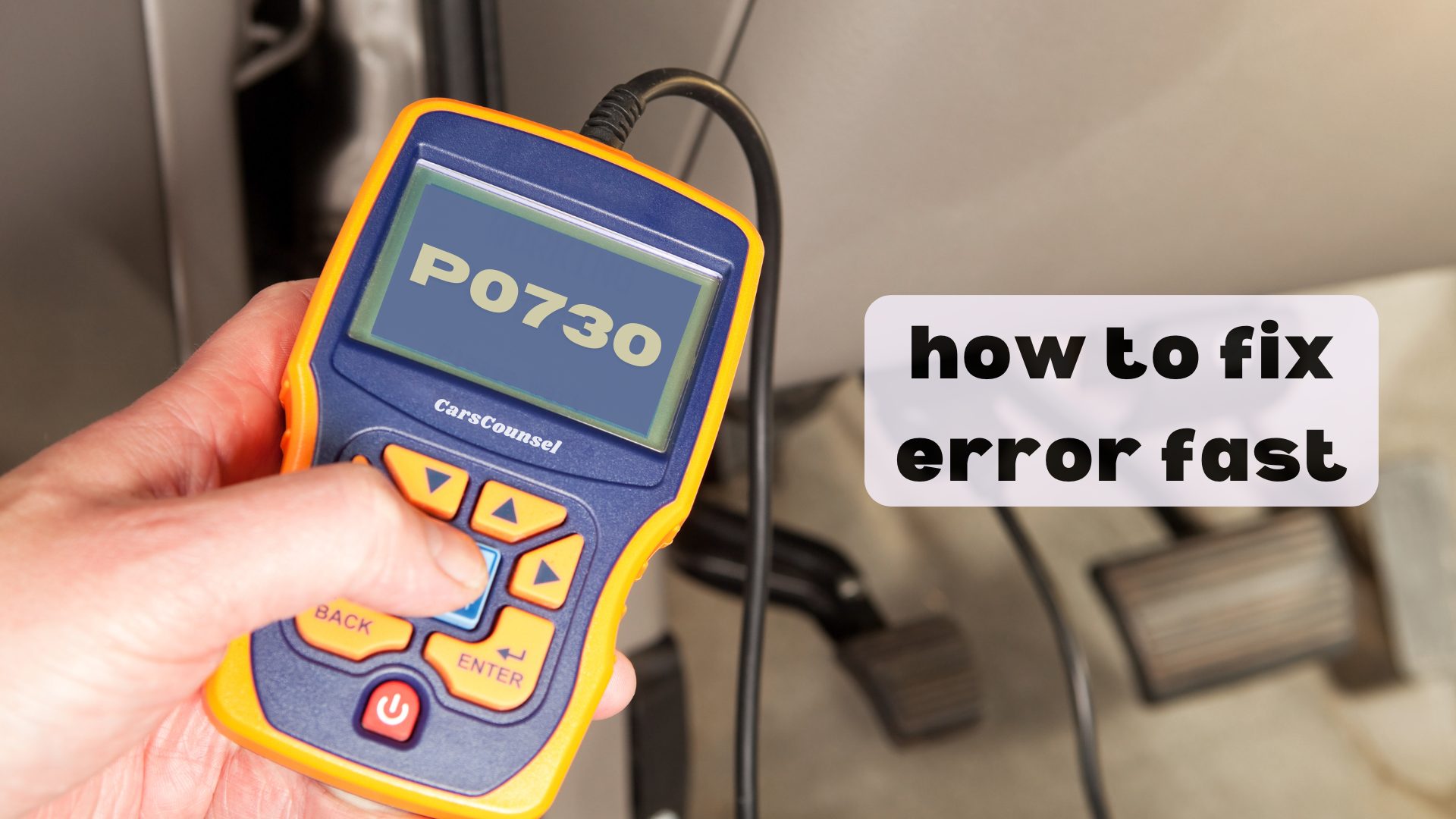When your car shows a P0730 code, it means there’s a problem with the transmission’s gear ratio, which can cause serious driving issues if not fixed quickly.
First, check the transmission fluid to make sure it’s clean and at the right level—this simple step can often make a big difference.
Next, look at the sensors and wiring to see if there’s any damage, as faulty electrical parts can make the problem worse.
Using an OBD-II scanner can help find related OBD2 Codes, giving you more information.
To really understand and fix the issue, there’s more you should know about diagnosing and solving this problem effectively.

Quick Navigation
Key Takeaways
- Check the transmission fluid level and make sure it’s clean and filled correctly.
- Use an OBD-II scanner to find the P0730 code and any other related codes.
- Look for and replace any bad sensors, solenoids, or wiring in the transmission control system.
- Take the car for a drive to see how the transmission behaves and gather real-time data.
What Is the P0730 Code?
The P0730 code means that your car’s transmission has detected a problem with the gear ratio, meaning the input and output shaft speeds don’t match up correctly.
To figure out what’s wrong, start by using an OBD-II scanner to confirm the P0730 code and see if there are any other related codes.
Check the transmission fluid level and its condition since low or dirty fluid can cause gear ratio problems.
Look at the electrical parts like sensors and wiring to see if there are any issues.
Take the car for a drive to recreate the conditions when the code shows up to ensure you get consistent results.
Lastly, do a thorough check of the transmission parts and run pressure tests to find any internal mechanical problems that might be affecting the gear ratio.
Symptoms of P0730 Code
If you’re seeing a P0730 code, you’ll likely notice some clear symptoms like shaking when you change gears, the transmission slipping, and gear shifts that are either delayed or very rough.
These problems are important to pay attention to. First, watch for any strange shaking or shuddering when your car shifts gears. Next, be aware if your car unexpectedly slips out of gear. Also, notice if the shifts feel delayed or very jerky.
These symptoms mean that your transmission isn’t keeping the right gear ratio. It’s crucial to deal with these issues quickly to avoid more damage.
Always use an OBD-II scanner to confirm the P0730 code and follow a step-by-step process to find out what’s causing the problem.
Common Causes
Several common issues can cause a P0730 code, so you’ll need a step-by-step approach to figure out and fix the problem.
First, check if the transmission fluid is low or dirty. Keeping the transmission fluid clean and at the right level is crucial, so top it up or change it if needed.
Next, look for worn-out parts in the transmission, like damaged gears or clutch plates, as these can mess up gear ratios.
Electrical problems, like faulty sensors or solenoids, are also typical causes. Make sure all the wiring and connections to the Transmission Control Module (TCM) are in good shape.
Lastly, don’t forget the TCM itself; software bugs or physical damage can also misread gear ratios.
Impacted Car Models
When diagnosing the P0730 code, keep in mind that some car models are more likely to have transmission issues. Ford, Honda, and Toyota are among the manufacturers commonly affected, with the Ford Focus and Honda Accord (2008-2012) being notable examples.
These models often show problems like gear slippage and incorrect gear ratios. It’s important to know if your car has an automatic or continuously variable transmission (CVT), as these issues mainly occur in automatic transmissions.
Start by researching the specific model and year of your car to understand the common transmission problems it might have. This focused approach helps you find the root cause quickly and efficiently, ensuring you fix the issue without unnecessary delays.
Correctly identifying the affected manufacturers and transmission types is crucial for resolving the P0730 code.
Using an OBD-II Scanner
Using an OBD-II scanner is the first step to find out more about the P0730 code and any other related codes.
Start by connecting your OBD-II scanner to the diagnostic port, which is usually under the dashboard. Turn on your vehicle’s ignition without starting the engine. The scanner will then talk to the car’s computer system and show any trouble codes.
Using the scanner helps you quickly find error codes, saving time and avoiding guesswork. Once you confirm the P0730 code, take note of any other codes that might give you more clues about the problem.
This first step is crucial for accurate troubleshooting and making sure repairs are done correctly.
Checking Transmission Fluid
To check your transmission fluid, first park your car on a flat surface and let the engine warm up to its normal temperature.
Then, find the transmission dipstick, which is usually in the engine bay.
With the engine running, pull out the dipstick, wipe it clean, put it back in all the way, and then pull it out again to check the fluid level.
The fluid should be between the ‘Full’ and ‘Add’ marks.
Also, check the fluid’s condition: it should be a bright, clear red.
If it’s dark or smells burnt, it needs to be replaced.
Keeping the fluid at the right level and in good condition is important for your transmission’s health and can help prevent or fix P0730 errors.
Inspecting Electrical Components
Start by taking a good look at all the wiring and connectors linked to the transmission control system.
Look for any signs of damage, rust, or loose connections. Check if the wiring harness has any wear or frayed parts, as these can cause electrical problems that come and go. Make sure all connectors are plugged in properly and are clean.
Next, use a multimeter to test the transmission sensors to make sure they’re working right. Pay extra attention to the input and output speed sensors, since they’re crucial for calculating the correct gear ratios.
If you find any damaged or faulty parts, fix or replace them right away. Doing this thorough check and testing will help you sort out any electrical issues causing the P0730 code.
Performing a Road Test
During the road test, watch how the vehicle behaves to spot any problems with shifting and performance that might indicate the P0730 code.
Start by driving under different conditions, like accelerating from a stop, cruising at steady speeds, and slowing down. Look out for issues like delayed shifts, rough gear changes, or slipping gears.
Keep detailed notes of what you observe. Use a diagnostic scanner to capture real-time data on the transmission. This will help you link the driving conditions to any gear ratio problems.
If you keep seeing issues, move on to a more thorough inspection to make sure your findings are correct and complete.
Comprehensive Transmission Inspection
Comprehensive Transmission Inspection
A thorough transmission inspection usually means taking a good look at the transmission parts and testing the pressure to find any internal problems. Start by checking for leaks, wear, and damage in the transmission casing. Then, use a pressure gauge to measure fluid pressure at different points to spot any issues.
Here’s a simple breakdown:
| Step | Action |
|---|---|
| 1 | Look at the outside of the transmission for leaks and damage |
| 2 | Check the inside parts for wear and tear |
| 3 | Use a pressure gauge to test the fluid pressure at key spots |
| 4 | Look for metal shavings in the fluid |
| 5 | Check the solenoids and sensors to see if they are faulty |
These steps in checking the transmission help you figure out why the P0730 code is showing up, making sure you can fix it accurately and efficiently.
Fixing and Preventing P0730
To fix and prevent the P0730 code, you’ll need to address fluid issues, repair electrical components, and maintain your transmission regularly.
Here’s a simple guide:
- Change the Fluid: Regularly replace low or dirty transmission fluid to keep everything running smoothly.
- Fix Electrical Problems: Check and repair any faulty solenoids, sensors, and wiring to ensure they’re communicating correctly with the Transmission Control Module (TCM).
- Do Routine Inspections: Schedule regular check-ups to catch early signs of wear and tear, which can help extend the life of your transmission.
More OBD-II Codes
Frequently Asked Questions
Can Driving With a P0730 Code Cause More Damage to My Car?
Yes, driving with a P0730 code can cause more damage to your car. Fix transmission problems quickly using diagnostic tools to avoid serious damage. Ignoring them can lead to expensive repairs and major transmission failures.
How Much Does It Cost to Fix a P0730 Code?
Fixing a P0730 code can cost between $1500 and $4000, depending on what’s wrong. Use diagnostic tools to check for things like fluid changes, replacing solenoids, or fixing the transmission control module to keep costs down.
Is It Safe to Drive With a P0730 Code?
Driving with a P0730 code isn’t safe. Problems like transmission issues, shaking, and slippage can get worse and cause serious damage. Fix these issues right away to avoid expensive repairs and keep your car safe.
Can I Fix a P0730 Code Myself Without Professional Help?
Yes, you can try to fix P0730 transmission issues yourself. Begin by checking and replacing the transmission fluid if it’s low or dirty. Look for any damaged wiring, and use an OBD-II scanner to find and fix specific problems.
Will Fixing a P0730 Code Improve My Car’s Fuel Efficiency?
Did you know that improving how your car’s transmission works can make it up to 15% more fuel-efficient? Fixing a P0730 code helps solve gear ratio problems, which reduces slippage and makes your car run better, saving you gas.
Conclusion
As you tighten the last bolt, you feel relieved—your car’s transmission is ready to go. The P0730 code is no longer a problem.
Imagine a smooth drive with seamless gear shifts and the satisfaction of a job well done.
But remember, staying alert is important. Regular maintenance, prompt inspections, and quick repairs are your best friends.
Keep your OBD-II scanner handy and your transmission fluid clean, and you’ll be ready for any challenge ahead.

